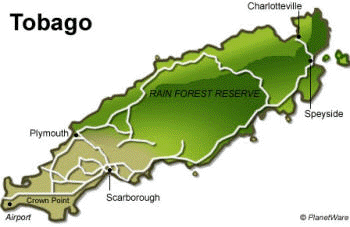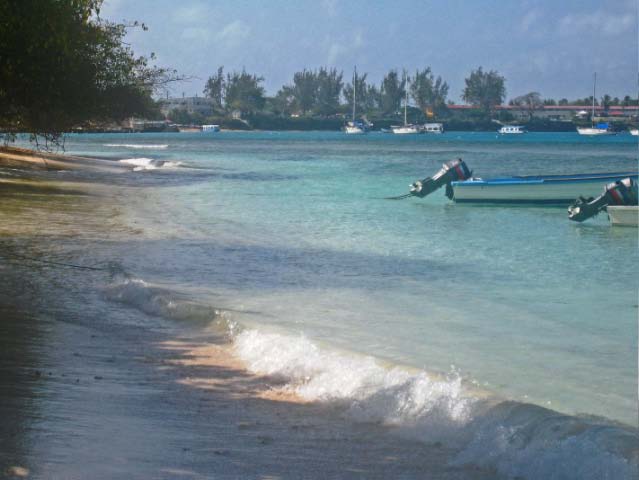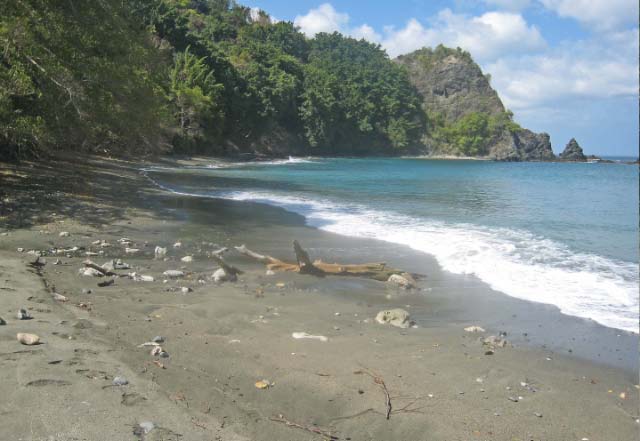 February
24/10 February
24/10
We really wanted to visit Tobago but the
weather wasn't suited to sail there with our
boat. So we decided to take a ferry across
and make a 2 day holiday sleeping on a bed
that didn't move!
A maxi taxi trip to Port of Spain, then a 2
1/2 hr ferry ride and we disembarked at
Scarborough in Tobago. Tobago, the smaller
island of Trinidad & Tobago, lies about 35
km North-East of the island of Trinidad.
Sailing to Tobago from Trinidad can be a
challenging upwind, against the current,
run. So the $16 round trip journey provided
a nice break from the boat.
| 
|
Tobago has been voted the world's top
eco-tourism destination (2003). Fertile
with continental diversity from the time
when Tobago and Trinidad were joined to
the South American mainland, it
encompasses the oldest protected
rainforest in the western hemisphere.
The island's diversity includes 210
species of birds, 133 species of
butterflies, 25 species of snake (none
poisonous), 6 species of lizard, to name
a few. |
 |
 |
We stayed at Hummingbird near Store Bay, a
clean family run guesthouse with swimming
pool and meals available for $50/night.
Along with a blind dog and audacious cat,
the resident parrot was entertaining. It was
about a 20 minute walk to the water through
a safe non-descript neighborhood.
|
 |
 |
|
 |
We rented a car for 2 days and drove pretty
much every inch of the 40 km long and 12 km
wide tropical paradise. Virtually the whole
of the island is covered by abundant
vegetation or agriculture. The locals,
overwhelmingly of African origin, many with
Indian features, enjoy a livelihood based on
cocoa plantation farming and fishing.
Tourism apparently plays a big role in their
economy although we certainly didn't see
many foreigners or facilities to accommodate
them. |
|
 |
What we experienced were laid back, easy
going stress free villages with friendly
people waving to us as we drove by. Tobagp,
characterized by a mountainous range that
runs from the South-West to the North-East,
the highest peak being 576 meters above sea
level, offered splendid views of pretty bays
and sandy beaches. We travelled the coastal
route around the island, taking inland
detours when we came across an interesting
road.
|
 |
Tobago has some lovely beaches, many
completely deserted. The Caribbean side has
the calmer white sand stretches, while the
Atlantic side has surfing beaches, rocky
with dark sand and rough waters.
Throughout the island are numerous
waterfalls but, being the dry season, many
were only a trickle. We did hike to
Argyle Falls which took us through a
coffee plantation and the rain forest. |
 | |
Although we didn't use a guide, we met
Alison when we finished our hike and
gave her a ride to the fish market and
back. She was a flamboyant, colorful
women and we enjoyed her company for the
short duration of the drive. She gave us
100% pure cocoa balls from the
plantation that you could drop in hot
water to make cocoa. |
Topographically, Tobago distinguishes
itself strongly from its sibling island.
The reason may be that Tobago separated
itself from the main island during
earlier geological eras, even as
Trinidad was separating itself from the
South America (by continental drift). As
a result, there are many species of
animals and birds found on Tobago that
are not on Trinidad. In search of unique
bird sightings we took to many back
roads, always apprehensive about the
rutted dirt roads and our low clearance
rental car!
We did see many sightings, including the
illusive Rufous Chachacarus (right),
Tobago's national bird. Also, Horned
Beaked Blackbirds, Motmots (left),
Kingfishers and some others we couldn't
identify. |

|
|
|
|
|
|
|
